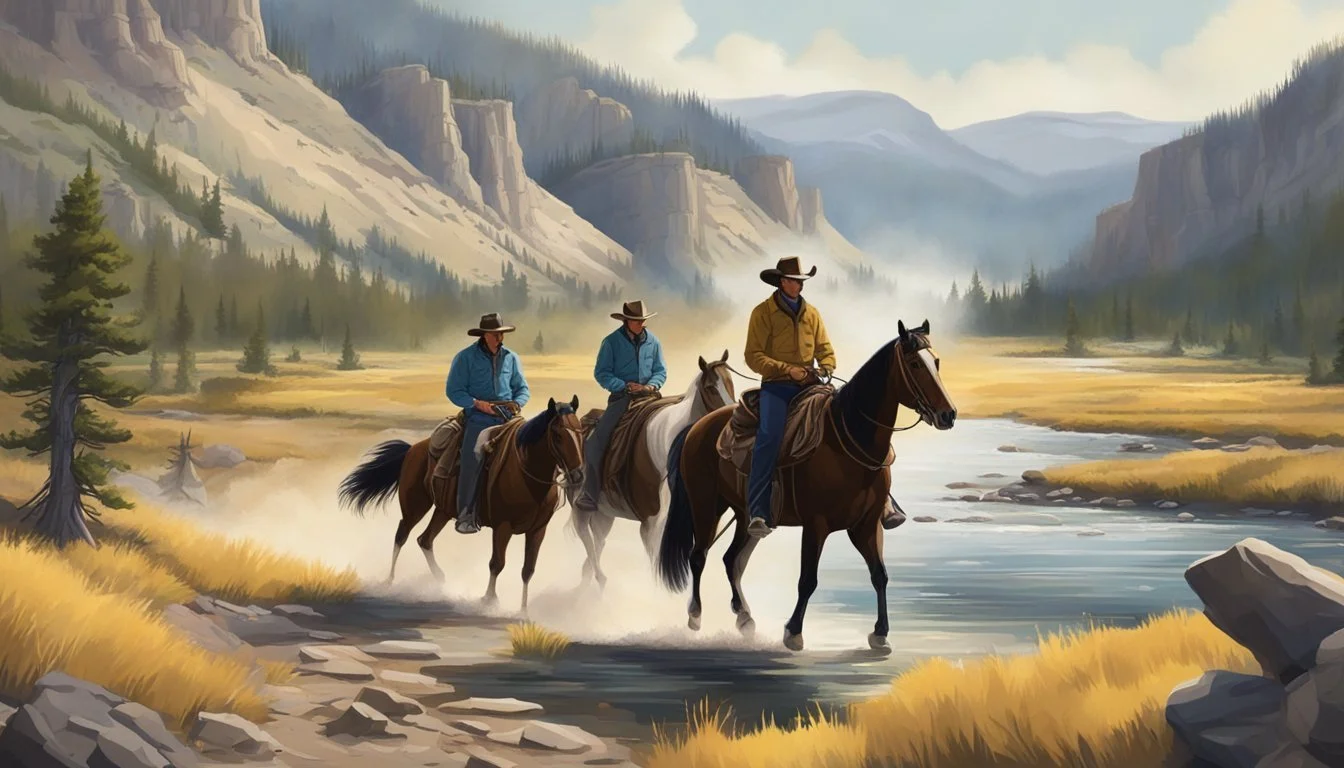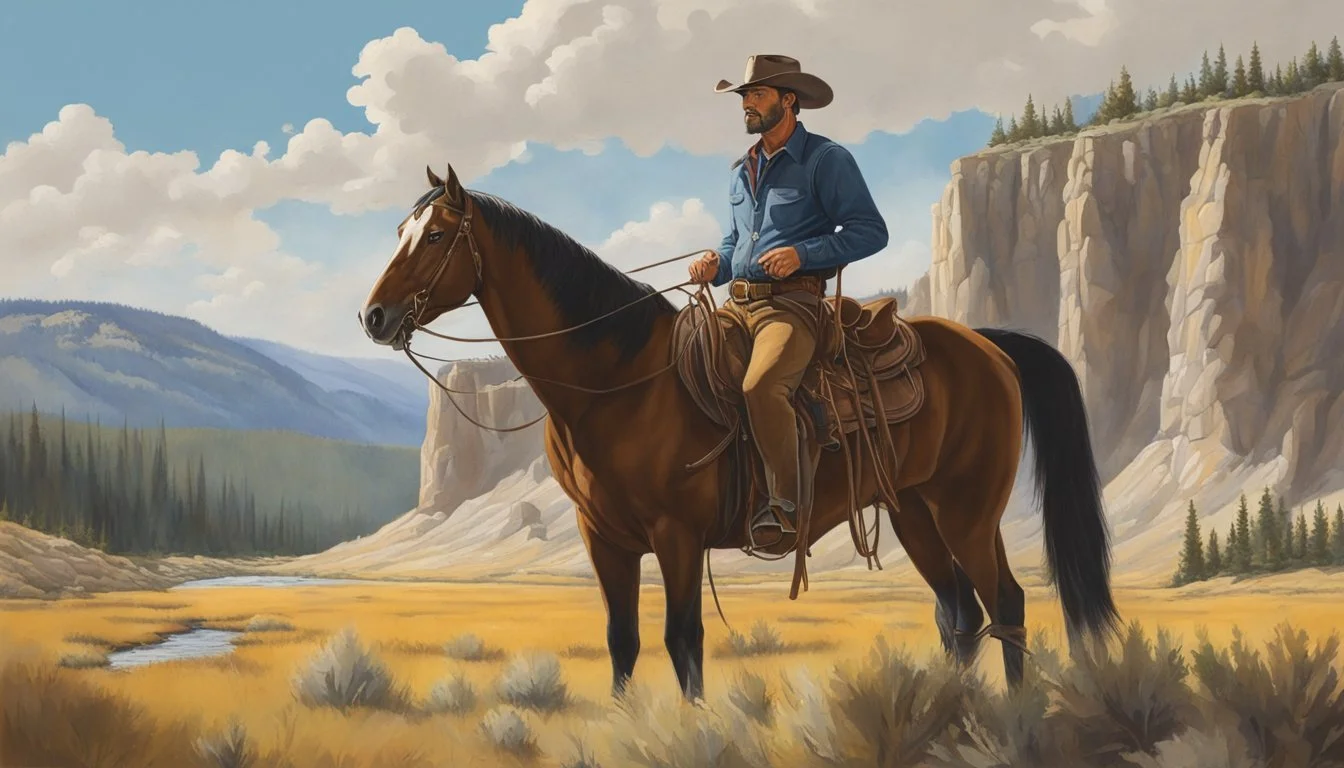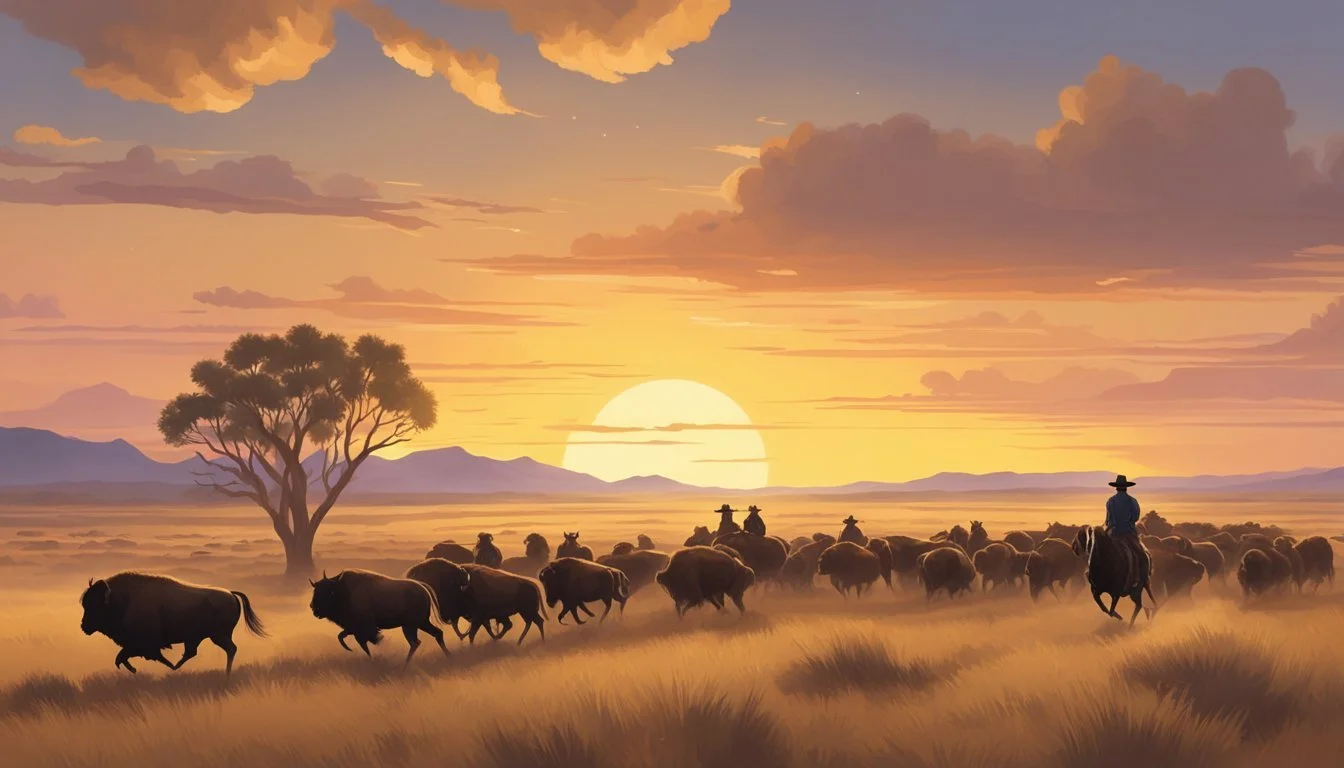Wolves in Yellowstone Show Unleash Secrets That Could Change Everything
Wolves play a significant role in the hit Paramount Network series "Yellowstone," created by Taylor Sheridan. These majestic creatures serve as powerful symbols throughout the show, representing both the untamed wilderness and the characters' internal struggles. The wolves in "Yellowstone" often appear at pivotal moments, carrying deeper meaning and foreshadowing important events in the storyline.
The show's portrayal of wolves draws inspiration from the real-life reintroduction of wolves to Yellowstone National Park in 1995. This connection to reality adds depth to the series, blending fact with fiction. The wolves' presence in "Yellowstone" highlights the delicate balance between humans and nature, a central theme explored throughout the show.
Viewers of "Yellowstone" have witnessed several memorable encounters between characters and wolves. These scenes range from tense standoffs to more symbolic interactions, each adding layers to the complex narrative. The wolves' appearances often coincide with moments of personal growth or conflict for key characters, particularly the Dutton family members.
The Premise of 'Yellowstone'
'Yellowstone' centers on the Dutton family's struggle to maintain control of their vast Montana ranch. The show explores themes of power, family loyalty, and the clash between tradition and progress in the American West.
John Dutton's Legacy
John Dutton, the patriarch of the Dutton family, fiercely protects his sprawling Yellowstone Ranch. As the largest contiguous ranch in the United States, it faces constant threats from land developers, Native American reservations, and the nearby Yellowstone National Park.
John's determination to preserve his family's legacy drives much of the show's conflict. He employs both legal and questionable tactics to keep the ranch intact, often putting him at odds with various adversaries.
The ranch represents generations of Dutton history and John's children grapple with the weight of this inheritance.
Wilder Than the West
'Yellowstone' portrays a modern Wild West where violence and corruption are commonplace. The show doesn't shy away from depicting brutal confrontations and morally ambiguous decisions.
Characters frequently resort to extreme measures to protect their interests. This includes physical altercations, political maneuvering, and even murder.
The series showcases the rugged beauty of Montana's landscape, contrasting it with the harsh realities of those who inhabit it. This juxtaposition highlights the untamed nature of both the land and its people.
Ranching as a Way of Life
The show delves deep into the challenges of modern-day ranching in Montana. It portrays the daily operations of the Yellowstone Ranch, from cattle drives to dealing with predators.
'Yellowstone' emphasizes the cultural significance of ranching in the region. The Duttons and their allies view their way of life as endangered, threatened by encroaching modernization and changing societal values.
The series explores the economic pressures facing ranchers, including land disputes, market fluctuations, and environmental regulations. These challenges add depth to the characters' motivations and actions throughout the show.
Plot and Storyline
The Yellowstone TV series weaves together family drama, power struggles, and symbolic imagery. At its core, the show follows the Dutton family's fight to maintain control of their vast ranch.
The Dutton Family Drama
John Dutton leads his children Beth, Kayce, and Jamie in protecting their legacy. Beth, fierce and loyal, clashes with her adopted brother Jamie. Kayce balances family duties with his relationship with wife Monica and son Tate. Rip Wheeler, the ranch foreman, provides unwavering support to the Duttons.
Family tensions run high as each member grapples with their role and ambitions. Beth's sharp wit and ruthless tactics contrast with Kayce's more conflicted approach. Jamie's complex relationship with his adoptive family creates ongoing friction.
Persistent Threats
The Dutton ranch faces constant challenges from developers, rival ranchers, and political opponents. Land disputes, corporate takeovers, and legal battles threaten their hold on the property. Native American interests, represented by Monica's family, add another layer of conflict.
External forces attempt to exploit divisions within the family. The struggle for succession looms large as John Dutton considers the future of the ranch. Each threat tests the family's resolve and unity.
Wolves' Symbolism
Wolves play a significant symbolic role in Yellowstone. They represent both a threat to the ranch's cattle and a connection to the wild nature of the land. Kayce's encounters with wolves highlight his spiritual link to Native American culture.
The predators mirror the Duttons' own fierce protection of their territory. Wolf packs' social structures parallel the family dynamics at play. Their presence serves as a reminder of the delicate balance between civilization and wilderness that the Duttons strive to maintain.
The Evolution of Characters
Yellowstone's characters undergo profound transformations as the series progresses. Conflicts, alliances, and the harsh Montana landscape shape their identities in compelling ways.
Character Development
John Dutton evolves from a stoic rancher to a more emotionally vulnerable leader. His children also change dramatically. Beth becomes more empathetic while maintaining her fierce loyalty. Kayce struggles to balance his roles as a father, husband, and Dutton.
Rip Wheeler grows from a hardened ranch hand to a trusted family member. His relationship with Beth softens his edges.
Jamie's arc is perhaps the most turbulent. He grapples with his identity and place within the Dutton family.
Carter, a newcomer, matures from a troubled youth to a valued member of the ranch community.
Alliances and Betrayals
The Dutton family's alliances shift constantly. Beth and Jamie's rivalry intensifies, while Kayce finds himself torn between his Native American wife's family and the ranch.
Rip's unwavering loyalty to John strengthens over time. This contrasts sharply with Jamie's wavering allegiance.
Minor characters form crucial alliances and betray the Duttons in surprising ways. These interactions add depth to the show's complex web of relationships.
Shepherds and Flock
John Dutton's role as the family patriarch evolves. He struggles to maintain control while preparing the next generation to take over.
Beth emerges as a fierce protector of the family legacy. She takes on a maternal role with Carter, revealing a softer side.
Kayce's leadership skills grow as he navigates tribal politics and ranch management. His son Tate represents the future of the Dutton legacy.
Rip's position shifts from enforcer to a more nuanced leader. He mentors younger ranch hands, passing on the Yellowstone way of life.
Unique Aspects of the Show
"Yellowstone" stands out for its cinematic beauty, authentic portrayal of Native perspectives, and integration of wildlife into the storytelling. These elements combine to create a distinctive viewing experience.
Cinematic Experience
Taylor Sheridan's direction brings the breathtaking landscapes of Montana and Wyoming to life. Sweeping aerial shots capture the vastness of Yellowstone National Park and surrounding areas. The show's cinematography highlights the rugged beauty of the American West, from snow-capped mountains to golden prairies.
Attention to visual detail extends to the authentic set designs and costumes. Ranch interiors and cowboy attire reflect meticulous research into modern Western life. This commitment to realism immerses viewers in the world of the Dutton ranch.
Portraying Native Perspectives
"Yellowstone" gives voice to Native American characters and issues often overlooked in Western media. The show explores complex relationships between tribes and non-Native ranchers. Land disputes, sovereignty, and cultural preservation feature prominently in storylines.
Native actors play key roles, bringing authenticity to their portrayals. The series tackles sensitive topics like generational trauma and the impact of reservations. By including these perspectives, "Yellowstone" offers a more nuanced view of the modern West.
Yellowstone's Wildlife
Wildlife plays a crucial role in the show's themes and symbolism. Wolves, bears, and other animals are not merely background elements but integral to the narrative. Their presence highlights the delicate balance between ranching and conservation.
The series explores real-world wildlife management issues. Storylines touch on predator control, conservation easements, and the reintroduction of species to Yellowstone National Park. These plotlines educate viewers on current environmental challenges in the region.
Animal encounters often carry deeper meanings. Wolves, in particular, serve as powerful metaphors throughout the series. Their appearances to characters like Kayce Dutton signal pivotal moments of reflection or transformation.
Casting and Performances
The cast of Yellowstone brings the Dutton family saga to life through powerful performances and complex character portrayals. From seasoned veterans to rising stars, the actors embody their roles with depth and nuance.
The Dutton Ensemble
Kevin Costner anchors the series as John Dutton, the steadfast patriarch of the Dutton family. His gravitas and screen presence lend weight to John's struggles to protect his ranch. Luke Grimes and Kelly Reilly shine as Dutton children Kayce and Beth, each grappling with their own demons while fiercely defending the family legacy.
Wes Bentley portrays the conflicted Jamie Dutton with a mix of ambition and vulnerability. Cole Hauser's rugged charisma brings ranch foreman Rip Wheeler to life, making him a fan favorite. The core cast's chemistry and individual performances drive the show's emotional core.
Supporting Characters and Guest Stars
Yellowstone's world extends beyond the Duttons through a rich tapestry of supporting characters. Gil Birmingham's portrayal of Thomas Rainwater adds depth to the land disputes central to the plot. Kelsey Asbille brings nuance to Monica Long Dutton, navigating her place between two worlds.
The show features notable guest stars who leave lasting impressions. Josh Holloway's roguish charm as Roarke Morris created a formidable adversary. Danny Huston's small but impactful role as Dan Jenkins added gravitas to early seasons' conflicts.
Veteran actors like Dabney Coleman and Jacki Weaver lend their talents as wily elders, enriching the show's multigenerational drama. These performances round out Yellowstone's world, creating a fully realized Montana landscape.
Themes and Imagery
Wolves in Yellowstone serve as powerful symbols, weaving together themes of nature's majesty, human legacy, and the struggle between civilization and wilderness. Their presence reflects deeper meanings within the show's narrative.
The Majesty of Montana
Montana's breathtaking landscapes form a stunning backdrop for Yellowstone's wolf encounters. The series showcases the state's rugged beauty, from snow-capped peaks to expansive prairies. Paradise Valley, with its pristine wilderness, becomes a focal point for wolf sightings. These scenes highlight the untamed spirit of the region and its diverse ecosystems.
Rare Snow Queens, a unique wolf pack, make occasional appearances, emphasizing the area's ecological richness. Their ethereal presence adds to the mystique of Montana's natural wonders, captivating both characters and viewers alike.
Legacy and Power
Wolves symbolize ancestral connections and spiritual power in Yellowstone. Kayce Dutton's interactions with a lone wolf mirror a Vision Quest, tying into Native American traditions. These encounters suggest a deeper understanding of nature and self.
The wolves represent wisdom and strength, often appearing at crucial moments in characters' journeys. Their presence challenges the Dutton family's legacy, forcing them to confront their place in the natural order.
Key wolf encounters:
Kayce's pact with a wolf
Beth and Rip's wolf-watching date
Lone wolf sightings during pivotal plot points
Man Versus Wild
Yellowstone explores the tension between human expansion and wildlife preservation. Wolves embody this conflict, representing both the threat to ranching interests and the importance of ecological balance.
The show portrays wolves as more than mere animals - they become symbols of nature's resilience against human encroachment. Characters like Kayce struggle with their roles as both protectors of the land and guardians of their family's interests.
This theme manifests in various ways:
Debates over wolf reintroduction
Conflicts between ranchers and conservationists
Characters' internal battles between their wild nature and civilized roles
Critical Reception and Influence
Yellowstone's critical reception has evolved significantly since its debut, with initial mixed reviews giving way to more positive ratings over time. The show's influence extends far beyond its viewership numbers, reshaping perceptions of the modern American West.
Pop Culture Footprint
Yellowstone has become a cultural phenomenon, sparking discussions about contemporary American life and values. The series has revitalized interest in Western-themed content, inspiring a new wave of rural-set dramas. Its portrayal of land ownership conflicts and family dynamics resonates with viewers across the country.
The show's popularity has led to increased tourism in Montana, where it is primarily filmed. Fans seek out locations featured in the series, boosting local economies. Yellowstone-inspired fashion, particularly cowboy hats and Western wear, has seen a resurgence in mainstream culture.
Industry Impact
Yellowstone's success has reshaped the television landscape. The show pioneered a new era of prestige TV set in rural America, prompting networks to invest in similar content. Its high production values and star-studded cast, led by Kevin Costner, have raised the bar for Western dramas.
The series' strong performance on cable and streaming platforms like fubo has challenged traditional notions of viewership. Its success across multiple seasons, particularly Season 3, has demonstrated the enduring appeal of well-crafted, character-driven narratives.
Yellowstone's influence extends to its expanding universe, with spin-offs and prequels in development. This franchise approach mirrors successful models seen in other popular series like Succession, further cementing Yellowstone's impact on the industry.
Behind the Scenes
The production of "Yellowstone" involves meticulous attention to detail and a commitment to authenticity. From carefully chosen filming locations to the intricate writing process, the show's creators work tirelessly to bring the world of the Dutton ranch to life.
Production Insights
"Yellowstone" primarily films at the Chief Joseph Ranch in Darby, Montana. This 2,500-acre working cattle ranch serves as the iconic Dutton family ranch, providing a genuine backdrop for many scenes. The main lodge, barns, and corrals are featured prominently throughout the series.
The production team goes to great lengths to ensure authenticity. They use real ranches and incorporate actual ranch activities into the filming process. This attention to detail helps create a believable and immersive world for viewers.
Writing and Direction
Taylor Sheridan, the show's creator and lead writer, draws from his own experiences growing up in rural Texas to craft authentic storylines and dialogue. His intimate knowledge of ranch life and Western culture informs the show's narrative depth.
The writing team carefully weaves symbolic elements into the story, such as the appearance of wolves and other wildlife. These elements often carry deeper meanings and foreshadow future events in the series.
Directors work closely with the cast to bring out nuanced performances that capture the complex relationships between characters and their environment. They focus on showcasing the rugged beauty of Montana's landscapes, which play a crucial role in the show's atmosphere.
Fandom and Community
Yellowstone has cultivated a passionate fanbase that engages in lively discussions and theories online. The show's popularity has also led to broader societal impacts, sparking conversations about modern ranching and land use issues.
Fan Theories and Discussions
Yellowstone fans flock to social media platforms and online forums to dissect each episode. Reddit and Facebook groups host spirited debates about character motivations and plot twists. Popular fan theories revolve around the Dutton family's future and potential betrayals within the ranch.
Streaming services have made it easier for viewers to rewatch episodes, fueling deeper analysis. Fans create detailed timelines and family trees to track the complex relationships on the show.
Many enthusiasts share their own experiences with ranch life, adding real-world context to the fictional drama. This blend of fiction and reality helps foster a sense of authenticity that resonates with viewers.
Yellowstone's Social Impact
The show has reignited interest in modern Western culture and lifestyle. Viewership spikes have been observed in rural areas, where audiences relate strongly to the ranching themes.
Yellowstone's portrayal of land disputes between ranchers, developers, and Native American tribes has prompted discussions about real-world conservation issues. Some viewers report gaining new perspectives on the challenges facing modern ranchers.
Tourism to Montana and Wyoming has increased, with fans eager to experience the scenic landscapes featured in the show. Local businesses have capitalized on this trend, offering Yellowstone-themed tours and merchandise.
The series has also influenced fashion, with Western wear seeing a resurgence in popularity among urban consumers. This cultural impact extends beyond clothing, affecting music choices and home decor trends as well.
Explore Yellowstone National Park
Yellowstone National Park offers a unique opportunity to witness wolves in their natural habitat. The reintroduction of wolves has had far-reaching effects on the park's ecosystem and wildlife.
Ecosystem and Conservation
Wolves play a crucial role in Yellowstone's ecological balance. Their presence has led to a trophic cascade, benefiting various species and habitats. Elk populations have decreased, allowing vegetation to recover in many areas.
This regrowth has provided habitats for beavers, birds, and small mammals. The park's rivers and streams have seen improvements in their structure and flow. Scavengers like ravens, eagles, and bears now have more carrion available from wolf kills.
Conservationists closely monitor wolf populations and their impacts. GPS collars help track wolf movements and behaviors. Researchers study pack dynamics, hunting patterns, and interactions with other species.
The Real Wolves of Yellowstone
Yellowstone's wolf packs have become famous worldwide. Visitors flock to the park for a chance to spot these elusive predators. The Lamar Valley, known as America's Serengeti, is a prime location for wolf watching.
Park rangers and wildlife guides offer educational programs about wolf behavior and ecology. Visitors can learn about pack hierarchies, hunting strategies, and communication methods. The wolves' howls echoing through the valleys create unforgettable experiences.
Wolf-watching has boosted local economies. Tourism related to wolves generates millions in revenue annually. This economic impact helps garner support for ongoing conservation efforts in the Greater Yellowstone Ecosystem.







